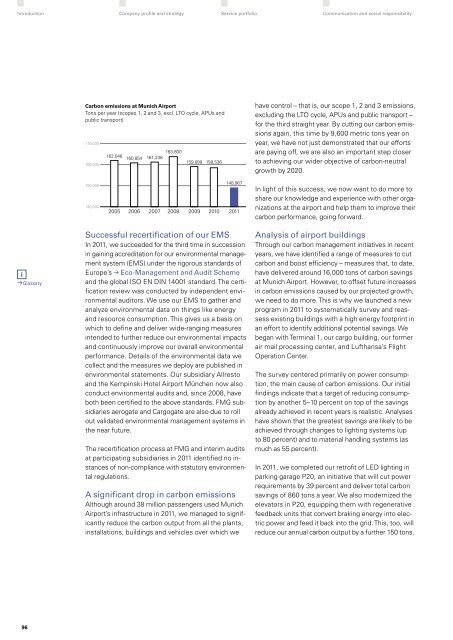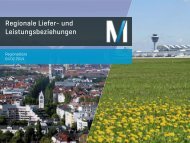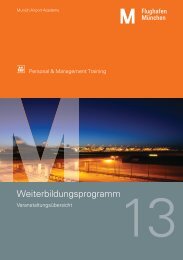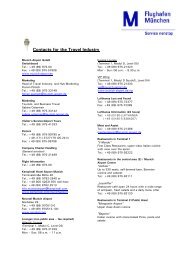"Perspectives 2011" - Sustainability and Annual Report (pdf)
"Perspectives 2011" - Sustainability and Annual Report (pdf)
"Perspectives 2011" - Sustainability and Annual Report (pdf)
You also want an ePaper? Increase the reach of your titles
YUMPU automatically turns print PDFs into web optimized ePapers that Google loves.
Introduction Company profile <strong>and</strong> strategyService portfolio Communication <strong>and</strong> social responsibilityCarbon emissions at Munich AirportTons per year (scopes 1, 2 <strong>and</strong> 3, excl. LTO cycle, APUs <strong>and</strong>public transport)170,000160,000163,800162,046 160,854 161,238159,089 158,536have control – that is, our scope 1, 2 <strong>and</strong> 3 emissions,excluding the LTO cycle, APUs <strong>and</strong> public transport –for the third straight year. By cutting our carbon emissionsagain, this time by 9,600 metric tons year onyear, we have not just demonstrated that our effortsare paying off, we are also an important step closerto achieving our wider objective of carbon-neutralgrowth by 2020.150,000140,000148,9672005 2006 2007 2008 2009 2010 2011In light of this success, we now want to do more toshare our knowledge <strong>and</strong> experience with other organizationsat the airport <strong>and</strong> help them to improve theircarbon performance, going forward.) GlossarySuccessful recertification of our EMSIn 2011, we succeeded for the third time in successionin gaining accreditation for our environmental managementsystem (EMS) under the rigorous st<strong>and</strong>ards ofEurope’s ) Eco-Management <strong>and</strong> Audit Scheme<strong>and</strong> the global ISO EN DIN 14001 st<strong>and</strong>ard. The certificationreview was conducted by independent environmentalauditors. We use our EMS to gather <strong>and</strong>analyze environmental data on things like energy<strong>and</strong> resource consumption. This gives us a basis onwhich to define <strong>and</strong> deliver wide-ranging measuresintended to further reduce our environmental impacts<strong>and</strong> continuously improve our overall environmentalperformance. Details of the environmental data wecollect <strong>and</strong> the measures we deploy are published inenvironmental statements. Our subsidiary Allresto<strong>and</strong> the Kempinski Hotel Airport München now alsoconduct environmental audits <strong>and</strong>, since 2008, haveboth been certified to the above st<strong>and</strong>ards. FMG subsidiariesaerogate <strong>and</strong> Cargogate are also due to rollout validated environmental management systems inthe near future.The recertification process at FMG <strong>and</strong> interim auditsat participating subsidiaries in 2011 identified no in -stances of non-compliance with statutory environmentalregulations.A significant drop in carbon emissionsAlthough around 38 million passengers used MunichAirport’s infrastructure in 2011, we managed to significantlyreduce the carbon output from all the plants,installations, buildings <strong>and</strong> vehicles over which weAnalysis of airport buildingsThrough our carbon management initiatives in recentyears, we have identified a range of measures to cutcarbon <strong>and</strong> boost efficiency – measures that, to date,have delivered around 16,000 tons of carbon savingsat Munich Airport. However, to offset future increasesin carbon emissions caused by our projected growth,we need to do more. This is why we launched a newprogram in 2011 to systematically survey <strong>and</strong> reassessexisting buildings with a high energy footprint inan effort to identify additional potential savings. Webegan with Terminal 1, our cargo building, our formerair mail processing center, <strong>and</strong> Lufthansa’s FlightOperation Center.The survey centered primarily on power consumption,the main cause of carbon emissions. Our initialfindings indicate that a target of reducing consumptionby another 5–10 percent on top of the savingsalready achieved in recent years is realistic. Analyseshave shown that the greatest savings are likely to beachieved through changes to lighting systems (upto 80 percent) <strong>and</strong> to material h<strong>and</strong>ling systems (asmuch as 55 percent).In 2011, we completed our retrofit of LED lighting inparking garage P20, an initiative that will cut powerrequirements by 39 percent <strong>and</strong> deliver total carbonsavings of 860 tons a year. We also modernized theelevators in P20, equipping them with regenerativefeedback units that convert braking energy into elec -tric power <strong>and</strong> feed it back into the grid. This, too, willreduce our annual carbon output by a further 150 tons.96
















